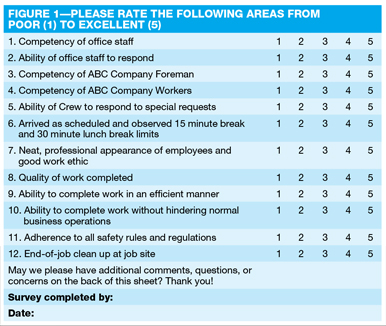
Chapter Ten
Excellent Customer Service
By Beth Borrego / Published March 2021

Perhaps one of the most easily overlooked portions of a business’s marketing efforts is customer service. So far, we have focused on everything that a business owner needs to do in order to successfully get the phone to ring and for customers to see the need to purchase their particular brand of goods or services among the many providers they have to choose from. But the people who answer the phone, who perform the service, and who interact with the customer on any level whatsoever have to be skilled in performing excellent customer service.
Let’s begin with the initial telephone inquiry. Regardless of whether you have an employee answering the phone or if you have hired an answering service, the person who answers the call should always be polite, friendly, patient, enthusiastic, empathetic, and quick thinking, and they should practice active listening.
Let’s look at these components briefly. Patience is something we all need help with from time to time. One of the biggest customer service challenges an employee faces is dealing with frustration and remaining professional at all times. Detaching from a customer’s anger or frustration and not taking it personally, while acknowledging the customer’s feelings, can be a real challenge for even the most seasoned employee. Let’s face it, everyone has difficult customers occasionally. Remaining patient is critical to handling a tough scenario.
Active listening is another component that all employees need to master in order to excel in customer service. Active listening means paying close attention to the person who is speaking, and it involves clearly communicating back to the customer what you have just heard to make sure you clearly understood what the customer has just communicated to you. Perhaps the most challenging thing about active listening is resisting the urge to interrupt the person who is speaking. If you are spending your listening time mentally planning your rebuttal, then you are not fully listening. Remember to listen first and perhaps make some notes; then verify what you heard by repeating it back in a synopsis. After that, you can explain what you need to address or answer questions.
Manners matter, so it should go without saying that everyone needs to be polite and courteous. Treat all of your customers with respect and dignity, as though they sincerely matter to your company, because they do! Using the title of Mr., Mrs., or Miss followed by their surname is appropriate until you are told otherwise. Saying please and thank you and addressing your customer as sir or ma’am is also appropriate. Depending on the practice in your area, avoid using familiar or personal nicknames or references like hon, honey, or sweetie. It can be considered unprofessional.
Being friendly is easy if you enjoy what you do and easier still if you do it with a smile on your face, even if the customer cannot see your smiling face. Leave your personal troubles out of your business transactions and focus on your business day. Admittedly, sometimes that’s easier said than done, but no matter what, always be friendly and professional.
Have you ever called a company and had someone who is absolutely monotone handle your call from beginning to end? Think about how you felt after that call. Was it frustrating? Did you feel as though you were not being heard? Did you wonder about the rest of the company’s service? Now, think about a time when you contacted a company and spoke to someone who was upbeat, enthusiastic, and personable. How did that call go? Which experience registered as superior customer service for you? Being enthusiastic is important. As the saying goes, enthusiasm is contagious, and people feel better about positive and enthusiastic experiences.
You should be well versed at what you do, or at least know your limitations. This also means you need to be a quick thinker and be able to get questions answered and problems solved quickly. Just remember—never make up what you don’t know. It’s far better to do a little research to get a correct answer than it is to create the incorrect answer and spawn a potential new problem.
It’s important to capture all of the basic information required from the customer in order to properly handle the request for an estimate. Some callers may not be a good fit for what your company does, and asking questions during the initial call helps to determine if the caller’s needs are a good match or if you need to refer them to another company. It’s important to be patient and an active listener with the caller because many people describe in layman’s terms what it is they are looking for. Once the caller has done this, repeat back to them what you believe they are interested in to confirm you have the information correct. People are typically pleased to know they’ve been understood and treat this kind of affirming response positively. Being friendly and speaking clearly are an important part of ensuring that the customer has a pleasant first experience with your company.
Most callers will have questions of their own to ask as well, so be enthusiastic about what your company has to offer, and be clear when you speak. Don’t eat while you are on the telephone or chew gum while you are speaking. If you are listening to a radio, keep the volume low to ensure the music doesn’t interfere with the conversation, as background noise or other loud sounds can be a distraction to both of you. Always make sure to ask the caller if there is anything else you can assist them with today, and then thank them and let them know that your company appreciates their business. It’s the little touches like this that make the difference between a poor, fair, good, great, or excellent first impression. Always strive for excellence.
There comes a time when the caller may come face to face with an estimator or service employee from your company, and the same customer service rules apply in these scenarios, too. Smile and introduce yourself, be polite, and maintain the appropriate amount of personal or social space between yourself and the customer. If you have to go into their home, wear a mask if that is still recommended by the CDC, and ask if you should remove your shoes. Many people appreciate that, and more than you think will take you up on it. You can also bring disposable shoe covers with you if you don’t want to have to remove and replace your footwear. Be sure to observe the laws regarding the use of PPE on the job site as well, and in the customer’s presence. Make sure that when you leave, you ask them if they have any other questions for you and then thank them for their time.
 Of course, we all hope that our customers enjoy positive experiences that they’ll be eager to share with others and that they’ll purchase our goods or services again in the future. Let’s take a look at both paper and electronic customer satisfaction surveys next. In the name of continual improvement, it’s a good idea to ask them to complete a satisfaction survey and to rate the work you have done. Let them know that you take their feedback seriously and that your company goal is continuous improvement. As an example, your survey may look something like FIGURE 1 on the left.
Of course, we all hope that our customers enjoy positive experiences that they’ll be eager to share with others and that they’ll purchase our goods or services again in the future. Let’s take a look at both paper and electronic customer satisfaction surveys next. In the name of continual improvement, it’s a good idea to ask them to complete a satisfaction survey and to rate the work you have done. Let them know that you take their feedback seriously and that your company goal is continuous improvement. As an example, your survey may look something like FIGURE 1 on the left.
Once you begin using the surveys, it is important to follow up with your customers when you receive back any survey that raises concerns. This may mean a telephone call, but it could also mean a trip to the job site to meet with the customer. This is your opportunity to take the feedback seriously and to better your company. Don’t miss this opportunity. Nobody likes criticism, but everyone likes praise. Thank your customer for their candor, and then tell yourself that hidden inside the criticism is the path to a solution that you may need.
Today many companies ask their clients for online reviews and offer automated feedback. Clients may leave reviews on third-party sites like Google or Yelp, Angie’s List, and so forth. It’s also possible to set up a feedback form on your website and have the feedback and review emailed to you as well. This is easily done using a form on your company website, and it is inexpensive to implement. As you can see, there are several ways to gather feedback from your clients.
Occasionally, even the best companies get complaints, but it is how each and every complaint is handled that determines if your customer service is truly excellent or not. Many contractors feel that once they have collected the check and performed the service, their work is complete. This could not be further from the truth. Ideally, you have a happy and satisfied customer who will not only use your company for many years to come but will also refer new business to you.
So let’s just suppose for a moment that you get a telephone call and that your customer indicates there is a problem with the service your crew recently performed. What do you do? Do you A) ignore the call and hope they go away, or B) get as much information as you can and offer the client a solution to address the issue so they will be satisfied? Obviously choice B is correct. Identify the problem, and offer the customer a solution so that they will be satisfied. Obviously, not all issues are simple, but the ideal of striving for excellent customer service means that sometimes you have to take extra steps to make sure you have a satisfied customer.






